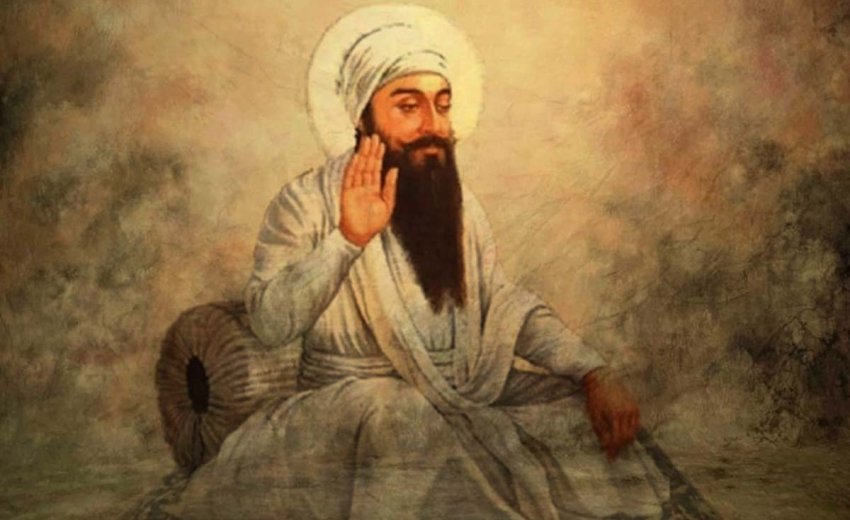Guru Arjan Dev Ji was the fifth Guru of Sikhs. He compiled the first official edition of the Sikh scripture called the Adi Granth, which later expanded into the Guru Granth Sahib.
His early life
Guru Arjan was born to Bibi Bhani and Jetha Sodhi in Goindval. Bibi Bhani was the daughter of Guru Amar Das, and her husband, Jetha Sodhi, who later went on to become the fourth Sikh Guru, Guru Ram Das Ji. The birthplace of Guru Arjan Dev Ji is currently known as the Gurdwara Chaubara Sahib. He had two brothers, Prithi Chand and Mahadev.
Different Sikh chroniclers cite his birth year as either 1553 or 1563, with the 15th of April as the accepted birthday. Scholarly consensus accepts 1563 as his true birth year.
Guru Arjan Dev Ji spent the first eleven years of his life at Goindwal and the next seven years in Ramdaspur with his father. As per historical records, he spent two years in Lahore as a youth after his father sent him there to attend the wedding of his first cousin Sahari Mal's son and to establish a Sikh congregation.
After his father died in 1581, he was appointed the Sikh Guru. Guru Ram Das Ji was a member of the Khatri subcaste Sodhi. Guruship remained in the Sodhi family of Guru Ram Das Ji after the succession of Guru Arjan.
Succession to become the 5th Sikh Guru
Guru Ram Das Ji chose the youngest of his son, Arjan, to succeed him as the fifth Sikh Guru. The middle brother, Mahadev, preferred the ascetic lifestyle. His selection of Arjan as successor, like in the majority of the history of Sikh Guru successions, led to conflicts and splits within the Sikh community.
The succession dispute regarding Guru Arjan Dev Ji caused a rift that resulted in two distinct narratives. In Sikh history, Prithi Chand is noted for his fierce opposition to Guru Arjan Dev Ji, which resulted in the formation of a Sikh sect. The Sikhs following Guru Arjan Dev Ji referred to the breakaway faction as Minas (meaning "scoundrels"), who allegedly attempted to kill young Guru Hargobind Ji and allied themselves with Mughal agents.
Later competing writings published by the Minas presented an alternative interpretation of the attempt on Hargobind Ji's life. Miharvan, the eldest son of Prithi Chand, is recounted in both traditions as having received childhood guidance from both Prithi Chand and Guru Arjan Dev Ji.
The opposing texts recognise the differences. It states Prithi Chand left Amritsar, and became the Sahib Guru after the martyrdom of Guru Arjan and disputed the succession of Guru Hargobind as the next Guru. The adherents of Prithi Chand considered themselves to be Guru Nanak's legitimate followers since they rejected stronger reliance on the militarization of the panth under Guru Hargobind Ji. While Guru Hargobind Ji favoured militarization to oppose Mughal persecution following Guru Arjan's martyrdom, the Minas were in favour of nonviolent interiorization.
In addition to Prithi Chand, a son of Guru Amar Das Ji named Baba Mohan had questioned Guru Arjan's authority. Baba Mohan held the Goindval pothi, which contained hymns by Nanak and other early Gurus, whereas Prithi Chand possessed the Guru Harsahai pothi, which was said to be the earliest scripture from Guru Nanak's time. Scholars believe that this prompted Guru Arjan Dev Ji to write a considerably larger, official edition of the Adi Granth.
In the Sikh tradition, Guru Arjan Dev Ji is considered to be the fifth Guru and Guru Hargobind Ji is considered to be the sixth Guru. In the year 1581, at the age of 18, Guru Arjan Dev Ji succeeded his father as the fifth Guru after receiving the position from his father. In the year 1606 CE, his son Guru Hargobind Ji succeeded him as the sixth Guru after his father was put to death by Muslim officials working for the Mughal Empire.
His legacy
Guru Ram Das Ji founded the town of Ramdaspur, which is built around the Ramdas Sarovar, a huge man-made water pool. Guru Arjan Dev Ji continued his father's work on building the infrastructure. During his reign, the town expanded, financed by donations and constructed by voluntary work. The resulting city, now known as Amritsar, is the holiest pilgrimage place in Sikhism.
Guru Arjan Dev Ji established Amritsar as a prominent Sikh pilgrimage site, building on the efforts of Guru Ram Das Ji. He composed large volumes of Sikh scripture, including the well-known Sukhmani Sahib. Guru Arjan Dev Ji is credited with completing several other infrastructural projects, such as the Santokhsar (lake of peace) and Gongsar (lake of Gongaga) water reservoirs, as well as building the cities of Tarn Taran, Kartarpur, and Hargobindpur.
Between 1581 and 1589, during the first decade of his guruship, Guru Arjan Dev Ji used dasvand donations to complete the construction of Harmandir Sahib, which served as a community meeting place, a hub for Sikh activity, and a location for the installation of the Adi Granth. He also visited Majha and Doaba in Punjab, where he founded the towns which later played a major role in the prosperity of the Sikh community, especially the Jatt peasantry. Guru Arjan Dev Ji acted as both a spiritual guide and a self-governing leader for his followers.
His role in compiling Adi Granth
Sikh history holds that Guru Arjan Dev Ji compiled the Adi Granth by collecting hymns of previous Gurus from various sources. He eliminated those that he believed to be fake or to be deviating from the teachings of the Gurus. His approved collection contained hymns he had written, those of the first four Gurus of Sikhism, as well as those of 17 Hindu bards and 2 Muslim bards. According to Sikh history, the compilation was finished on August 30 in 1604 and it was installed in the Harmandir Sahib temple on September 1 of the same year.
Guru Arjan Dev Ji was a brilliant poet who composed 2,218 hymns. More than half of the volume of Guru Granth Sahib and the largest collection of hymns have been composed by him.
After Guru Arjan Dev Ji completed and installed the Adi Granth in the Harmandir Sahib, Emperor Akbar was informed of the development with the allegation that it contained teachings hostile to Islam. He ordered a copy to be brought to him. Guru Arjan sent him a copy on a thali (plate), with the following message that was later added to the expanded text:
In this thali (dish) you will find three things – truth, peace and contemplation:
in this too the nectar Name which is the support of all humanity.
— AG 1429, Translated by William Owen Cole and Piara Singh Sambhi
One of the disagreements within the Sikh community after Guru Ram Das Ji was the development of new hymns purporting to have been written by Guru Nanak Dev Ji. According to the faction led by Guru Arjan Dev Ji, these hymns were falsified and forged, with some attributing their composition and distribution to Prithi Chand and his Sikh faction. There were concerns about the possibilities of false propaganda, immoral teachings, and falsified Gurbani. Guru Arjan Dev Ji initiated a massive effort to collect, study, approve, and create a written canonical text, which he named Adi Granth. This was the first edition of the Sikh scripture, published in 1604.
The compositions of both Prithi Chand and his disciples have been preserved in the Mina texts of Sikhism, but the mainstream and broader Sikh tradition adopted the Guru Granth Sahib scripture that eventually formed through Guru Arjan Dev Ji's initiative.
Final Years
Guru Arjan Dev Ji died in Mughal custody. This has been one of the defining, albeit contentious, events in Sikh history.
Most Mughal historians viewed Guru Arjan Dev Ji's death as a political incident, claiming that the Sikhs had become a formidable social group and that Sikh Gurus participated actively in Punjabi political battles. A similar theory proposed in the early 20th century says that this was merely a solitary execution motivated by politics. According to this idea, there was an ongoing Mughal dynasty struggle between Jahangir and his son Khusrau, whom Jahangir accused of insurrection, and Guru Arjan blessed Khusrau and therefore the losing side. Jahangir was jealous and enraged, so he ordered the execution of Guru Ji.
The Sikh tradition holds a contrary viewpoint. It asserts that the killing of the Guru was part of the continuous persecution of the Sikhs by Islamic authorities in the Mughal Empire. The Mughal rulers of Punjab were worried about the development of the Panth. According to Jahangir's book Tuzk-e-Jahangiri (Jahangirnama), which recounted Guru Arjan's support for his rebellious son Khusrau Mirza, the Sikh panth had to be annihilated if Guru Arjan Dev Ji would not convert to Islam.
In 1606 CE, Guru Ji was imprisoned in Lahore Fort, where, according to some sources, he was tortured and executed. He was forced to sit on a sheet/plate that was on fire, and then hot sand was poured over him. After five days of torment, he was given a river bath. He disappeared into the river, never to be seen again. However, according to other accounts, the manner of his death is undetermined. According to the ancient Sikh narrative, the Mughal emperor Jahangir imposed a fine of 200,000 rupees and ordered that Guru Arjan remove the offending hymns from the book. According to Sikh sources, Guru Ji's refusal to erase the lines and pay the punishment led to his execution.
Guru Arjan Dev Ji, according to Sikh legend, instructed his son and successor Guru Hargobind Ji to take up arms and combat oppression before his execution. His execution prompted the Sikh panth to arm itself and pursue resistance to Mughal tyranny. His martyrdom is commemorated annually in May or June as Shaheedi Divas.
Guru Arjun Dev Ji's commitment and death strengthened the Sikhs' notion that personal piety must have a moral centre. A noble spirit must also be a courageous soul.

